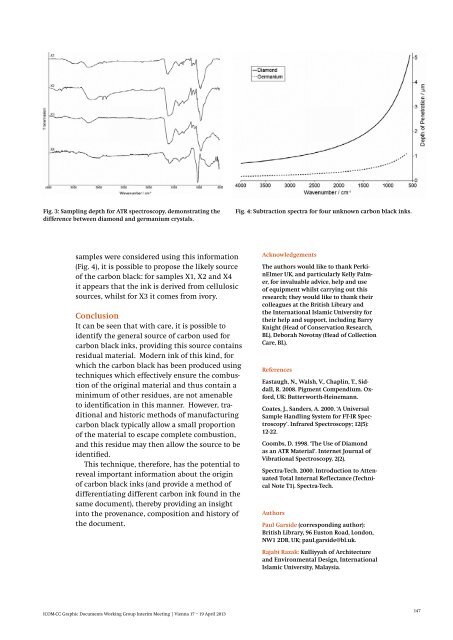Paper Conservation: Decisions & Compromises
Paper Conservation: Decisions & Compromises
Paper Conservation: Decisions & Compromises
Create successful ePaper yourself
Turn your PDF publications into a flip-book with our unique Google optimized e-Paper software.
Fig. 3: Sampling depth for ATR spectroscopy, demonstrating the<br />
difference between diamond and germanium crystals.<br />
Fig. 4: Subtraction spectra for four unknown carbon black inks.<br />
samples were considered using this information<br />
(Fig. 4), it is possible to propose the likely source<br />
of the carbon black: for samples X1, X2 and X4<br />
it appears that the ink is derived from cellulosic<br />
sources, whilst for X3 it comes from ivory.<br />
Conclusion<br />
It can be seen that with care, it is possible to<br />
identify the general source of carbon used for<br />
carbon black inks, providing this source contains<br />
residual material. Modern ink of this kind, for<br />
which the carbon black has been produced using<br />
techniques which effectively ensure the combustion<br />
of the original material and thus contain a<br />
minimum of other residues, are not amenable<br />
to identification in this manner. However, traditional<br />
and historic methods of manufacturing<br />
carbon black typically allow a small proportion<br />
of the material to escape complete combustion,<br />
and this residue may then allow the source to be<br />
identified.<br />
This technique, therefore, has the potential to<br />
reveal important information about the origin<br />
of carbon black inks (and provide a method of<br />
differentiating different carbon ink found in the<br />
same document), thereby providing an insight<br />
into the provenance, composition and history of<br />
the document.<br />
Acknowledgements<br />
The authors would like to thank PerkinElmer<br />
UK, and particularly Kelly Palmer,<br />
for invaluable advice, help and use<br />
of equipment whilst carrying out this<br />
research; they would like to thank their<br />
colleagues at the British Library and<br />
the International Islamic University for<br />
their help and support, including Barry<br />
Knight (Head of <strong>Conservation</strong> Research,<br />
BL), Deborah Novotny (Head of Collection<br />
Care, BL).<br />
References<br />
Eastaugh, N., Walsh, V., Chaplin, T., Siddall,<br />
R. 2008. Pigment Compendium. Oxford,<br />
UK: Butterworth-Heinemann.<br />
Coates, J., Sanders, A. 2000. ‘A Universal<br />
Sample Handling System for FT-IR Spectroscopy’.<br />
Infrared Spectroscopy; 12(5):<br />
12-22.<br />
Coombs, D. 1998. ‘The Use of Diamond<br />
as an ATR Material’. Internet Journal of<br />
Vibrational Spectroscopy. 2(2).<br />
Spectra-Tech. 2000. Introduction to Attenuated<br />
Total Internal Reflectance (Technical<br />
Note T1). Spectra-Tech.<br />
Authors<br />
Paul Garside (corresponding author):<br />
British Library, 96 Euston Road, London,<br />
NW1 2DB, UK; paul.garside@bl.uk.<br />
Rajabi Razak: Kulliyyah of Architecture<br />
and Environmental Design, International<br />
Islamic University, Malaysia.<br />
ICOM-CC Graphic Documents Working Group Interim Meeting | Vienna 17 – 19 April 2013<br />
147
















